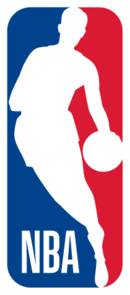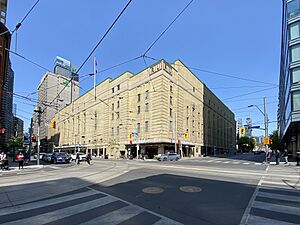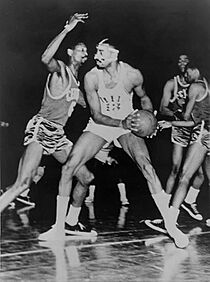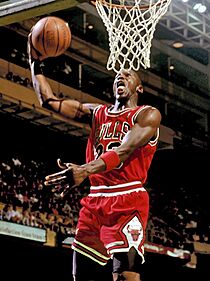National Basketball Association facts for kids
 |
|
| Sport | Basketball |
|---|---|
| Founded | June 6, 1946 (as BAA), New York City, New York, U.S. |
| Inaugural season | 1946–47 |
| Commissioner | Adam Silver |
| No. of teams | 30 |
| Countries | United States (29 teams) Canada (1 team) |
| Headquarters | 645 Fifth Avenue New York City, New York, U.S. |
| Most recent champion(s) |
Oklahoma City Thunder (2nd title) |
| Most titles | Boston Celtics (18 titles) |
| TV partner(s) | |
The National Basketball Association (NBA) is the top professional basketball league in the world. It has 30 teams, with 29 located in the United States and one in Canada. The league's main office is in New York City.
The NBA began in 1946 as the Basketball Association of America (BAA). In 1949, it joined with another league called the National Basketball League (NBL) and changed its name to the NBA. Today, the NBA is one of the most popular sports leagues globally. The players are among the best-paid athletes in the world.
The Boston Celtics have won the most championships, with 18 titles. The current champions are the Oklahoma City Thunder, who won the 2025 NBA Finals.
Contents
History of the NBA
How the League Started (1946–1956)
The league was founded on June 6, 1946, in New York City. The very first game took place on November 1, 1946, in Toronto, Canada. The Toronto Huskies played against the New York Knicks. Ossie Schectman of the Knicks scored the first basket in league history.
In the early years, there were other basketball leagues. The NBA (then called the BAA) wanted to play in big arenas in major cities. In 1949, the BAA merged with the NBL to form the National Basketball Association.
In the 1950s, the Minneapolis Lakers were the first powerful team, or "dynasty." Led by star player George Mikan, they won five championships. To make the game faster and more exciting, the league added the 24-second shot clock in 1954. This rule meant teams had to shoot the ball quickly, which increased scoring.
The Celtics and Expansion (1956–1979)
In 1957, Bill Russell joined the Boston Celtics. Along with guard Bob Cousy and coach Red Auerbach, Russell led the Celtics to win 11 championships in 13 seasons. During this time, center Wilt Chamberlain was also a huge star. He set a record by scoring 100 points in a single game. The rivalry between Russell and Chamberlain is one of the most famous in sports history.
The league grew larger in the 1960s and 70s. New teams joined, like the Chicago Bulls and Phoenix Suns. In 1967, a rival league called the American Basketball Association (ABA) was formed. The NBA and ABA competed for players and fans. In 1976, the two leagues merged. Four ABA teams joined the NBA: the San Antonio Spurs, Denver Nuggets, Indiana Pacers, and New York Nets (now Brooklyn Nets).
Magic, Bird, and Jordan (1979–1998)
In 1979, the NBA added the three-point line, which changed how the game was played. That same year, two famous rookies arrived: Larry Bird (Boston Celtics) and Magic Johnson (Los Angeles Lakers). Their exciting rivalry made basketball very popular on television. During the 1980s, the Lakers won five titles and the Celtics won three.
In 1984, Michael Jordan joined the Chicago Bulls. He became a global superstar. Jordan and his teammate Scottie Pippen led the Bulls to six championships in the 1990s. In 1992, NBA players were allowed to play in the Olympic Games for the first time. The U.S. team, known as the "Dream Team," featured Jordan, Bird, Johnson, and other legends. They won the gold medal and helped make basketball popular all over the world.
In 1995, the NBA expanded to Canada again by adding the Vancouver Grizzlies and the Toronto Raptors. In 1996, the NBA helped start a women's league, the Women's National Basketball Association (WNBA).
Modern Era and Recent Champions (1998–Present)
After Michael Jordan retired from the Bulls, the Western Conference became very strong. The Los Angeles Lakers, led by Kobe Bryant and Shaquille O'Neal, won three titles in a row from 2000 to 2002. The San Antonio Spurs, led by Tim Duncan, won five championships between 1999 and 2014.

In the 2010s, LeBron James became the face of the league. He reached the NBA Finals eight years in a row with the Miami Heat and Cleveland Cavaliers, winning three titles during that span. The Golden State Warriors also built a dynasty led by Stephen Curry. They won four championships between 2015 and 2022.
Recently, the league has seen many different teams win. This is called an era of "parity," meaning many teams have a fair chance to be champions.
- In 2019, the Toronto Raptors won their first title.
- In 2021, the Milwaukee Bucks won for the first time in 50 years.
- In 2023, the Denver Nuggets won their first-ever championship.
- In 2024, the Boston Celtics won their 18th title.
- In 2025, the Oklahoma City Thunder won the championship, led by MVP Shai Gilgeous-Alexander.
NBA Teams
There are 30 teams in the NBA. They are divided into two conferences: the Eastern Conference** and the **Western Conference. Each conference has three divisions.
How the Season Works
Regular Season
The NBA regular season usually starts in October and ends in April. Each team plays 82 games. They play 41 games at home and 41 games away. Teams play against opponents in their own division and conference more often than teams from the other conference.
In February, the league takes a break for the NBA All-Star Game. Fans and coaches vote for the best players to compete in this exhibition game. The weekend also includes fun events like the Slam Dunk Contest and the Three-Point Contest.
Playoffs and Finals

The playoffs begin in April. The top teams from the Eastern and Western Conferences compete in a tournament.
- Teams play a "best-of-seven" series. This means the first team to win four games moves on to the next round.
- The winners of the Eastern Conference and Western Conference meet in the NBA Finals.
- The winner of the Finals becomes the NBA Champion and receives the Larry O'Brien Championship Trophy.
- The best player in the Finals is given the Bill Russell NBA Finals Most Valuable Player Award.
Famous Players and Awards
The NBA honors its best players with yearly awards:
- Most Valuable Player (MVP): Given to the best player of the regular season.
- Rookie of the Year: Given to the best first-year player.
- Defensive Player of the Year: Given to the best defender.
- Sixth Man of the Year: Given to the best substitute player.
International Stars
Basketball has become a global sport. Many of the NBA's top players come from countries outside the United States.
- Hakeem Olajuwon (Nigeria) was a dominant center in the 1990s.
- Dirk Nowitzki (Germany) led the Dallas Mavericks to a title in 2011.
- Giannis Antetokounmpo (Greece) won two MVP awards and a championship with the Milwaukee Bucks.
- Nikola Jokić (Serbia) is a three-time MVP and led the Denver Nuggets to a title in 2023.
- Luka Dončić (Slovenia) is a multi-time All-Star.
- Shai Gilgeous-Alexander (Canada) was the 2025 MVP and led the Oklahoma City Thunder to the championship.
Helping the Community
The NBA has a program called NBA Cares. This program works to help people around the world. NBA teams and players support education, youth and family development, and health-related causes. They often participate in charity events and build places for kids to live, learn, and play.
See also
 In Spanish: National Basketball Association para niños
In Spanish: National Basketball Association para niños
- List of NBA regular season records
- List of NBA awards
- List of NBA seasons
- NBA cheerleading
- List of NBA rivalries
- NBA salary cap
- List of NBA playoff series
- NBA Summer League
- List of NBA franchise post-season droughts
- List of NBA franchise post-season streaks
- NBA Store





